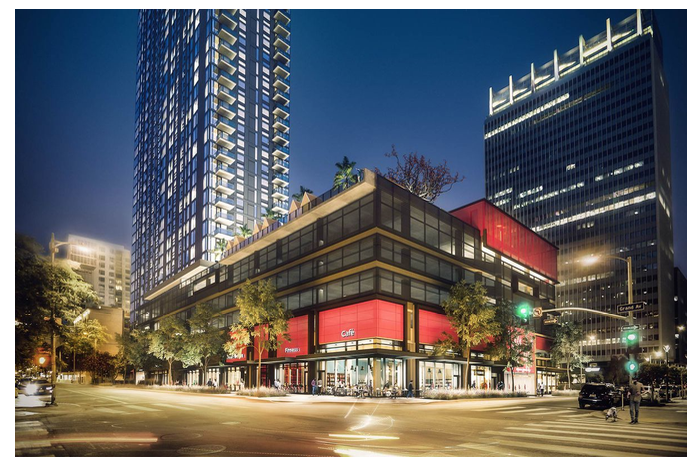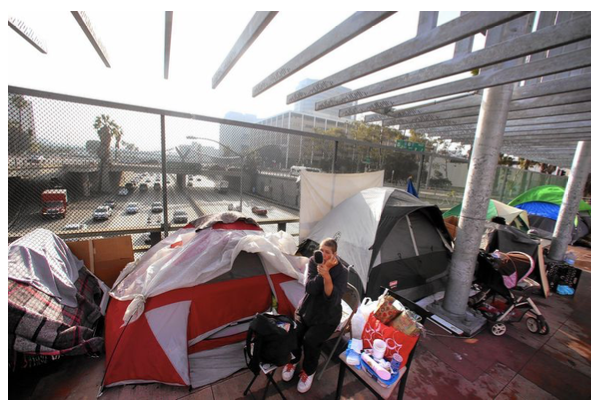CommentsPLATKIN ON PLANNING-No, your eyes aren’t lying. Los Angeles is experiencing a building boom, mostly high-rise luxury hotels and apartments in a few select neighborhoods.
Some are already open, others are under construction, and the rest are either pulling permits or finalizing financing. Those claims that LA’s zoning is so restrictive that it prevents housing construction are simply not credible. They are, in fact, disproven by these carefully researched and frequently updated real estate publications.
Urbanize LA lists each of these new real estate projects by neighborhood, address, and status, along with a photograph or rendering. Furthermore, Urbanize LA divides the metropolitan area into 14 regions and 120 neighborhoods. This allows readers to determine what new housing is available, under construction, or proposed for any part of the greater Los Angeles area.
The Los Angeles Development Map is updated daily and shows these and many other real estate projects. It also color-codes these real estate projects, allowing readers to quickly determine which ones are proposals, under construction, already opened, or delayed.
Curbed LA is a supplemental source for these databases. For example, its recent articles focused on 15 real estate projects near the Los Angeles river, likely developments in downtown Chinatown, Hollywood’s development boom, and 33 new high-rise luxury hotels and apartment buildings that will change LA’s skyline. If it is a major housing project, Curbed LA will describe it in a new story.
The Orange County Register has also analyzed and mapped this new construction. Even though the bulk of it is in Los Angeles, other parts of Los Angeles Country, as well as adjoining areas, especially Orange County, are experiencing the same boom, mostly luxury apartment buildings.
Who benefits? Those who celebrate this new construction are the same people and groups who directly and indirectly benefit from it. First, of course, are the giddy investors. Their underperforming capital will now produce annual profits of 15 to 20 percent per year from premium real estate in Los Angeles. The pols, of course, are also happy as clams because the same real estate investors finance their campaigns. Plus, in between elections, their donors are not burdened by moral scruples when it comes to pay-to-play. Other members of the real estate industry, like chambers of commerce, some academics, construction unions, realtors, rental agents, boosters, and newspapers running their ads, are also raising their champagne glasses for these projects.
Who is hurt? If you are not in one of these groups, you should expect that these projects will eventually hurt you, even if you believe the spin that a rising tide lifts all boats. This is because when it comes to speculative real estate investments, like these many high-end projects, we do not live in a win-win world. If you are a commuter, a pedestrian, a bicyclist, a tenant, a homeowner, or someone habituated to breathing, you will ultimately pay a price for living amidst such luxury.
My predictions for these mega-projects sprouting up throughout Los Angeles should help identify the complex downside of living in the shadows of “prosperity.”
1) These projects – at least those built before the real estate bubble bursts -- will have large parking structures. The well-off tenants who can afford their high rents want a convenient place to park their cars. If it isn’t there, they will have their pick of hundreds of vacancies in other apartment buildings with on-site parking.
2) The property managers will not offer tenants METRO tap cards. Nearly all these new buildings are transit adjacent, but few tenants will select them because they are near a bus stop or rail station.
3) Few tenants will use nearby mass transit, including METRO locals, express buses, light rail, and heavy rail subways. They can afford cars, which in LA means they will drive them for most trips.
4) Transit ridership will continue to decline on nearby mass transit lines, and the new apartment buildings will be Transit Oriented Development (TOD) in name only. Declining transit ridership is well documented, especially in neighborhoods with new transit-adjacent apartment buildings.
5) Traffic congestion at intersections and streets near the new high-rise apartment buildings will continue to get worse. When tenants drive cars, they quickly fill up streets and freeways beyond capacity.
8) The new buildings’ rents, like the buildings themselves, will be sky-high, and nearly all of the tenants will be well-off.
7) The buildings completing Environmental Impact Reports (EIR) will report unmitigable levels of Green House Gases. In these cases, the City Council will then adopt a Statement of Overriding Considerations. They will maintain that these adverse impacts should be ignored because each project increases transit ridership.
8) Once the Council certifies each EIR, no one from City Hall will ever verify the transit ridership claims. No City department will ever monitor these luxury real estate projects to document their claims that their tenants are frequent transit riders.
9) Many of the new apartment buildings will reduce their parking requirements by offering on-site bicycle parking, and most of these bicycle parking places will remain vacant, even though future tenants will gladly pay for an on-site parking.
10) Rents in older, nearby apartments will be pulled up, not pushed down by the new luxury apartments despite the increase, sometimes dramatic, in housing supply.
11) New homeless encampments will appear near many of these high-rise luxury apartment buildings. Over half of this homeless population will be Angelenos priced out of existing housing.
12) Press reports will describe and photograph these homeless encampments but will not link them to the construction of luxury high rise apartment buildings pulling up rents and displacing existing middle- and low-income tenants.
13) The new high-rise apartment buildings will hang “For Rent” signs on their buildings for years, and many of them will discreetly rent out vacant units for short-term rentals, such as Airbnb.
14) No City Hall Departments will ever prosecute the investors, owners, developers, landlords, property managers, or tenants for illegally operating a hotel through short-term rentals.
15) None of the new luxury apartment buildings will fill vacant buildings by reducing their rents to become affordable. Instead, they will offer symbolic enticements, such as a free month’s rent or limited free parking,
16) Many of the new high-rise apartment buildings will push out lower income tenants, small businesses, and arts-connected businesses, such as galleries and dance studios, in two phases. The first phase will result from the demolition existing buildings to prepare new in-fill building sites. The second phase will be through rent increases flowing outward from the new, high-end structures.
17) Infrastructure and public services near the luxury high-rise buildings will increasingly fail, and no public officials will argue that improvements to supportive infrastructure should precede increases in residential density.
18) The investors and developers responsible for the new high-rise luxury buildings will remain major contributors to the campaigns of existing and aspiring City Hall officials.

19) Photographs and renderings for new high-rise apartments, like the above, will never include traffic jams and homeless people or encampments.
20) Abundant Housing, and similar YIMBY groups, will enthusiastically support high-rise apartment projects requiring discretionary zoning approvals. Once the City Council approves these projects, these cheerleaders will never circle back to confirm that their pet projects increased transit ridership, created trickle-down low-income housing, and reduced the generation of Green House Gases.
I invite readers to save this column and see if my predictions are accurate. If so, my sad conclusion is that LA’s downward spiral of neglect will continue, despite the sparkling new buildings, many opening just in time for the 2028 Olympics.
(Dick Platkin is a former Los Angeles city planner who reports on local planning controversies for City Watch. He serves on the Board of United Neighborhoods for Los Angeles (UN4LA) and welcomes comments and corrections at [email protected].) Prepped for CityWatch by Linda Abrams.

















